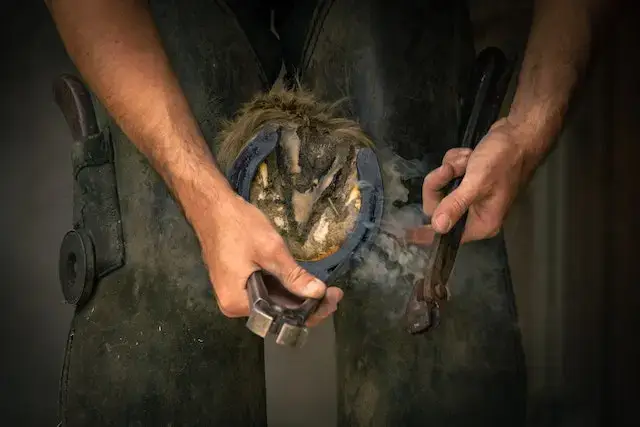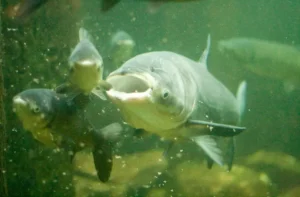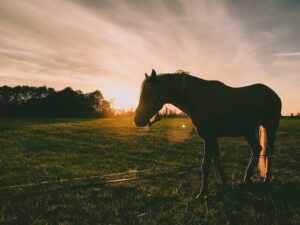Horses are very agile and fun-loving creatures. They engage in physical activities like running, jumping, galloping, etc., to maintain both their health and their mood.
A healthy horse’s hoof is, therefore, essential to maintain its productivity and athletic ability. How a horse’s hoof looks can give the caregiver a precise idea of any underlying problem that might be interfering with its physical performance on the field or the track.
So, let’s take a look at how a horse’s hoof should look.
How a Horse’s Hoof Should Look? Anatomy and Functions

An ideal horse hoof should have several key characteristics that support the health and performance of the horse. One of these characteristics is that the outer hoof wall should be pigmented and relatively stronger than the inner wall, as it bears the horse’s weight and shields its internal structures.
An optimal hoof should have a straight hoof-pastern angle, easy break-over, and balanced medial and lateral sides. Aside from that, each horse hoof should include two and a half bones: the coffin bone, the navicular bone, and the distal end of the short pastern bone.
Also, regular trimming is necessary for keeping the appropriate shape and length of the hoof. The angle of the coffin bone within the hoof is typically about 50 degrees, which can vary slightly depending on the horse’s specific needs.
Here are some more details about the anatomy and structure of a horse hoof:
1. Bone Structure
Each hope is made up of two and a half bones. The two large bones are the coffin bone and the navicular bone, and the distal end of a pastern bone connects to them.
The coffin bone protects the blood vessels and extends toward the end of the hoof. The navicular bone is the main bone that is injured during exercise.
It is the main foundation for the flexor tendon that is responsible for the movement, adjustment, and force absorption properties of the hoof. A digital cushion made of a special tissue covers the backside of the hoof – this part is responsible for maximum shock absorption.
2. Blood Supply
The hoof is provided blood by the medial and lateral arteries. Doctors check the intensity and frequency of digital pulses to determine any inflammation or infection inside the foot.
The foot is supplied by numerous, well-fed capillaries and has sensitive nerve endings to make up for the rigid structure of the external sole and hoof wall.
Therefore the overall cardiovascular health of your horse will have a direct and immediate effect on the hoof. The winds are located deep inside the coffin bone.
3. Appearance
If you take a careful look at the bottom view of the hoof, you will find the median groove extending all around the soul in the form of a side wall. The best thing you can do to increase your horse’s speed and decrease chances of injury is to invest in a properly made horseshoe that covers the side walls perfectly.
The dark hard part of the hoof that is visible to us when the horse is in a standing position is known as the hoof wall. The wall is covered by a waxy substance secreted by the periople.
A healthy hoof is constantly moisturized. The hoof wall also acts as an external shock absorber – it must be properly trimmed time and again to maintain a healthy horse’s hoof.
The triangular structure that covers a small part of the coffin bone and the digital question and lies just behind the sole is known as ‘the frog.’ If you find that the frog looks tiny, atrophied, or wounded, it might be time for immediate treatment.
From an external perspective, a hoof should always be smooth, even, and moist. The sole should be white in color and hard in feel.
Some Common Horse Hoof Diseases Are Listed Below:
- Hoof Abscess (growth of bacterial or fungal organisms)
- Thrush infection
- Hoof wall cracks
- Navicular disease (inflammation of the navicular bone and flexor tendon)
- Frog cancer
- Bone fracture or cyst
- Laminitis
When Does A Horse’s Hoof Need Treatment – 8 Common Symptoms!
Horse’s hoof care must form a special part of a caregiver’s weekly routine. Here is how you can tell if your horse’s hoof requires treatment:
1. Unfriendly aloofness
Horses are extremely friendly, and their sudden aloofness can be the biggest indicator that something is wrong. Generally, such a horse will show no interest in engaging with its caregiver or other horses, will not depict any competitive behavior, and generally refuse to communicate.
2. Physical appearance
Once you have a clear idea of how a horse’s hoof should look, you can do regular checks on your horse. If the horse’s hoof looks moldy or has a foul odor coming out of it, naturally, that is a sign of concern.
Bruises on the sole, black discharge from the hoof, or unusual angling of the hoof all need to be treated immediately. A cracked, dry, or uneven/brittle hoof is also a big cause of concern.
3. Sudden loss of appetite
Horses may show a sudden loss of appetite if they are injured or diseased. Monitor such a horse closely for a maximum of 2 to 3 days. Inspect at home, and if required, visit a vet immediately. Loss of appetite can be a sign of wounding, but it can also be a sign of an active disease or infection.
4. Lethargy or limp
The first symptom that points to horse hoof problems is a certain limp or laziness on the part of the horse. If the earliest signs are detected, regular horse hoof care at home can alleviate the situation. Conduct a complete evaluation of its hoof help as well as that of other body parts.
5. Rashes on the skin
A horse’s hoof infection can be local or can spread to other parts of the body. Rashes on the skin, falling out of coat hair, or deterioration of coat quality are the first signs of a fungal or viral disease.
6. Agitation or frustration
The horse will naturally feel irritated and agitated when it is hurting, and this will show as a general behavioral change of the horse in how it interacts with other humans and animals. Disobedience, kicking, biting, etc., must be monitored if they appear all of a sudden.
7. Uncommon vitals
A healthy horse has a very low pulse rate and breathing rate. An adult horse’s heart will beat from 28 to 40 times in a minute. Similarly, an adult horse will breathe 8 to 16 times in a minute. A strong breeding can indicate cardiovascular distress (similar to a strong pulse), which might mean that the horse’s hoof is suffering.
8. Warm feet
Another simple check is to touch the bottom of the hoof and check the temperature. If the hoof is unusually warm, it might be a symptom of a problem or a disease.
How Do You Take Care of Your Horse’s Hoofs?
There are many steps that you can take to ensure that your horse’s hoof looks clean, sturdy, and moisturized at all times. Maintaining the hoof is not complex at all; it only needs timely intervention.
- Hoof wall growth: horse’s hoof grows between 6 mm and 9.5 mm each month. For a running horse with shoes, the hoof wall growth must be trimmed every 6 to 8 weeks. Timely trimming can keep the hoof clean and reduce the chances of fungal growth, unnatural angling, etc.
- Monitored feeding habits: for a horse, its feeding habits are the biggest source of nourishment. A horse with adequate nutrients in its body will have a moisturized hoof and a strong immune system. Make sure your horse is fed an organic, high-quality diet every day and maintains a good calorie balance.
- Promoting overall health: the overall health of the horse in terms of its vitals, coat quality, general mood, appetite, water intake, performance speed, etc., must be monitored and then promoted through regular changes in the lifestyle of the horse.
- Sanitary living conditions: to minimize the chances of any bacterial, viral, or fungal disease, make sure that your horse is inhabiting a sanitary shed, eating clean food, and drinking clean water. Horses are clean animals and must be bathed daily. Clean the hoofs as often as possible, at least twice a week.
- Balancing horse’s hoof: just like trimming, balancing the hoof of the horse is also necessary. A healthy horse’s hoof is uniform on all sides. This uniformity helps the horse to maintain balance. Plus, it reduces the chances of diseases due to grime or dirt.
Final Thoughts
In this blog, we have elaborated on how a horse’s hoof should look and how to restore your horse’s hoof health with the help of easy and regular care regimens. Once you detect a horse hoof problem, however, the best course of action is always to consult an animal health professional and procure a proper treatment plan from them.
Frequently Asked Questions
Q1. How often should I trim a horse’s hoof?
Ans: A mature, healthy horse’s hoof should be trimmed every 3 or 4 weeks for a barefoot horse and every 6 to 8 weeks for a shod horse. If the horse is not in the habit of regular exercise, you might give a gap of 9 to 10 weeks.
Q2. How do I stop horse hoof infections from happening?
Ans: Caregivers can prevent horse hoof infections by feeding the horse a high-quality diet, housing it in sanitary conditions, conducting regular checkups and bathing, and cleaning the hoof routinely.
Q3. Why does my horse’s hoof look cracked?
Ans: A dry horse’s hoof looks cracked and brittle. Such a horse is unable to take up speed or run for long because of the constant pain. A proper diet and regular moisturizing can help the horse recover.



